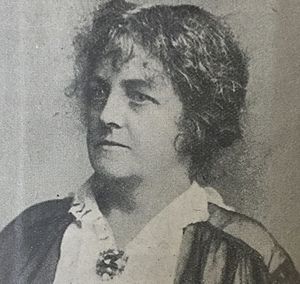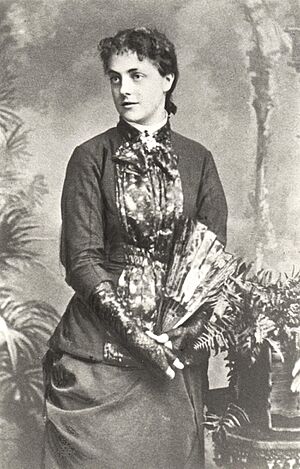Jennie Wyse Power facts for kids
Quick facts for kids
Jennie Wyse Power
|
|
|---|---|

Wyse Power in 1920
|
|
| Senator | |
| In office December 1922 – May 1936 |
|
| Vice President of Sinn Féin | |
| In office 1911–Unknown |
|
| Leader | Arthur Griffith |
| Preceded by | Arthur Griffith Bulmer Hobson |
| Succeeded by | Fr. Michael O'Flanagan Arthur Griffith |
| Personal details | |
| Born |
Jane O'Toole
1 May 1858 Baltinglass, County Wicklow, Ireland |
| Died | 5 January 1941 (aged 82) Dublin, County Dublin, Ireland |
| Resting place | Glasnevin Cemetery, Glasnevin, County Dublin, Ireland |
| Political party | Sinn Féin Fianna Fáil |
| Spouse | John Wyse Power |
| Occupation | Politician, Activist |
Jane Wyse Power (also known as Siobhán Bean an Phaoraigh; born O'Toole; 1 May 1858 – 5 January 1941) was an important Irish activist, a supporter of women's rights, a politician, and a businesswoman. She helped start two major groups: Sinn Féin and Inghinidhe na hÉireann. She became a very influential woman during the time of the Irish Revolution. As the leader of Cumann na mBan, she later left that group and created a new one called Cumann na Saoirse. She held several important positions in the Irish government during the time of the Irish Free State.
Contents
Growing Up in Ireland
Jennie Wyse Power was born Jane O'Toole in Baltinglass, County Wicklow, in 1858. Her parents were Edward O'Toole and Mary Norton. When she was only two years old, her family moved to Dublin.
Her family strongly supported Irish independence. They even gave shelter to members of the Fenians, a group who wanted Ireland to be free from British rule. Sadly, before she turned twenty, Jennie and her four brothers and sisters lost both their parents to illness.
Joining the Fight for Rights
In 1881, Jennie first became involved in politics. She joined the Ladies' Land League, a group that helped farmers in Ireland. She became good friends with Anna Catherine Parnell, who was a strong supporter of Irish rights. Jennie also admired Anna's brother, Charles Stewart Parnell, a famous Irish politician.
While working with the Ladies' Land League, she met her future husband, John Wyse Power. He was the editor of the Leinster Leader newspaper. He was also a member of the Irish Republican Brotherhood, another group working for Irish independence. John also helped start the Gaelic Athletic Association (GAA), which promotes Irish sports.
Jennie and John married on 5 July 1883 and lived in Naas, County Kildare.
Family Life and Business
In 1885, the family moved to Dublin when John got a job with the national Freeman's Journal newspaper. They had four children: Catherine (who died as a baby), Máire, Anne (called Nancy), and Charles. Their youngest son, Charles, was born after the death of Charles Stewart Parnell and was named after him.
In the same year, Jennie published a book called Words of the Dead Chief. It contained parts of Parnell's speeches. The Wyse Powers even appear as characters in a famous book called Ulysses by James Joyce.
After some political difficulties and the death of Charles Stewart Parnell, Jennie and her husband took a break from politics. However, Jennie remained active in the Dublin Women's Suffrage Association, which worked for women's right to vote.
In 1899, Jennie opened her own business in Dublin called the Irish Farm Produce Company. She sold Irish-made goods like eggs, butter, honey, and sweets. The shop also had a restaurant.
Early Political Steps
In 1900, Jennie was chosen as one of the Vice-Presidents of Inghinidhe na hÉireann. This was a women's group focused on Irish culture and independence. In 1903, she was elected as a Poor Law guardian for North Dublin. This role involved looking after the poor. She spoke out about poor housing and health conditions during her time in this role.
Jennie's restaurant became a popular meeting place for many Irish nationalists. These included members of the Gaelic League and the people who founded Sinn Féin. At the first meeting of Sinn Féin, Jennie was chosen to be on their executive committee.
In 1908, she opened another shop, again focusing on selling only Irish products. By 1912, Jennie Wyse Power was a Vice-President of Sinn Féin. On 5 April 1914, she helped found Cumann na mBan, a women's organization that supported the Irish Volunteers. On 31 October 1914, she became the first President of Cumann na mBan.
The Easter Rising and Its Aftermath
A very important event happened in Jennie's house on Henry Street: the Proclamation of the Irish Republic was signed there. During the Easter Rising in 1916, her house was destroyed by fire. Sadly, many historical records she had kept for 30 years were lost in the fire.
After the Rising, Jennie and her daughter, Nancy, helped to reorganize Cumann na mBan. They also helped distribute money sent from the United States to families who were struggling because of the Rising. At this time, her friend, Countess Markievicz, who was in prison, took over as President of Cumann na mBan. Jennie also joined the Irish Women's Franchise League, which worked for women's voting rights. After the Rising, Sinn Féin grew quickly, and Jennie helped prepare new female members.
The Irish Revolution
Jennie Wyse Power did not run in the 1918 Irish general election. However, she and other Cumann na mBan members worked hard to help Countess Markievicz get elected for Sinn Féin in Dublin.
In 1919, Jennie was made Treasurer of the Sinn Féin Executive. She wrote down their goals, which included bringing together "all shades of nationalist thought." In 1920, she was elected as one of five women to the Dublin Corporation. She had some trouble taking her seat because the clerk at first refused to let her sign her name in Irish.
For much of 1919, a room in her restaurant on Henry Street, Dublin, was used as the main office for the Irish Volunteers. In 1991, a plaque was placed at 21 Henry Street to mark Jennie Wyse Power's home and business. When a politician named Cosgrave was arrested in 1920, Jennie was part of a new Dáil (Irish Parliament) committee. This committee was set up to solve money problems in local government.
Jennie was also chosen by Michael Collins, a key leader, to help with his spy networks. By the end of 1921, Jennie believed that supporting the Anglo-Irish Treaty meant she would need to leave Cumann na mBan and form a new group. She felt that Cumann na mBan had become too focused on military actions.
Supporting the Treaty
Jennie Wyse Power had always supported efforts for Ireland to have its own government, including the 1912 Home Rule Bill. So, it made sense that she would support the Anglo-Irish Treaty, which aimed to create the Irish Free State. She was one of the few strong nationalist women to do so. Even though she supported the Treaty, she remained friends with people who were against it.
Along with other women who supported the Treaty, she helped set up Cumann na Saoirse (The League for Freedom) in March 1922. This new group replaced Cumann na mBan for those who supported the Treaty.
In December 1922, the President of the Executive Council, W. T. Cosgrave, appointed her to the Irish Free State Seanad Éireann (the Irish Senate). She was one of four women chosen for the first Seanad in 1922. The other women were Alice Stopford Green, Ellen Cuffe, Countess of Desart, and Eileen Costello.
Challenges and Later Years
During the Irish Civil War, properties belonging to Senators who supported the Free State were often attacked. On 10 December 1922, Jennie's business in Camden Street was bombed and badly damaged.
In 1922, Jennie Wyse Power and another Senator, Colonel Maurice George Moore, were the only ones who voted against appointing Lord Glenavy as the leader of the Seanad. They did this because Lord Glenavy had supported the British Union.
Jennie served on the Cumann na nGaedheal party's main committee. However, during her time in the Seanad, she became less happy with the government's policies. This was especially true regarding problems with the Boundary Commission, which was meant to decide the border with Northern Ireland. The last Cumann na nGaedheal meeting she attended was on 1 December 1925. After that, she sat as an independent Senator, meaning she didn't belong to a specific party.
When the Fianna Fáil party joined the Dáil and Seanad, Jennie often voted with them, along with Colonel Moore and Senator James Charles Dowdall. In 1934, her close friend, Seán T. O'Kelly, arranged for her daughter, Nancy, to work as his Private Secretary. O'Kelly likely convinced Jennie to join Fianna Fáil that year. She ran for the party in the 1934 Seanad Election and was re-elected for nine years. She served until the Seanad was ended in 1936. She spoke out against a bill that she felt treated women unfairly in the workplace.
Jennie Wyse Power passed away on 5 January 1941, at the age of 82, at her home in Dublin. She was buried in Glasnevin Cemetery with her husband and her daughter, Máire, who had died before her. Many people from both sides of the Dáil and the former revolutionary movement attended her funeral.


